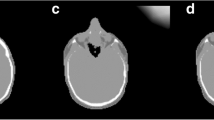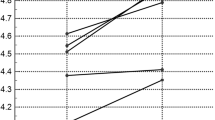Abstract
Objective
To objectify and quantify inter- and intra-observer variability of brain 18-FDG PET-CT interpretation in the context of cognitive and functional impairment amongst the elderly.
Methods
25 patients underwent brain 18-FDG PET-CT for investigation of dementia/MCI and frail elderly patients. Three observers interpreted studies in two forms: standardised datasets reconstructed by an outside observer and individualised reconstructions. Observers graded regional 18-FDG uptake in 11 brain areas and gave overall impressions on studies as pathological/normal. One observer repeated this process following a 3-month interval. The Kappa statistic was used to calculate inter- and intra-observer agreement on grading of regional 18-FDG uptake and overall impressions of studies as pathological/normal.
Results
Moderate inter-observer agreement was observed across standardised and individualised dataset reconstructions when 11 regional brain areas were compared cumulatively and overall impressions on studies were given as pathological vs normal. Higher levels of inter-observer agreement were found when comparing high versus low grading of regional uptake and when reporting standardised reconstructions. Intra-observer agreement between standardised vs individualised dataset reconstructions were moderate-to-fair across 11 brain regions cumulatively. Temporal intra-observer agreement of individualised dataset reconstructions comparing normal vs pathological opinions showed strong agreement (κ = 0.884 [95 % CI 0.662; 1.000)].
Conclusion
Despite a strong agreement in final diagnosis, this study demonstrates a moderate inter- and substantial intra-observer reproducibility in reporting brain 18-FDG PET-CT. Such results suggest that the visual analysis approach is different between nuclear physicians but leads to the same final diagnosis.


Similar content being viewed by others
References
Wimo A, Prince M. World Alzheimer report 2010: the global economic impact of Dementia. Alzheimer’s Disease International. Available online: http://www.alz.co.uk/research/files/WorldAlzheimerReport2010.pdf (2010). Accessed 27 Dec 2013.
Plassman BL, Langa KM, FIisher GG, Heeringa SG, Weir DR, Ofstedal MB, et al. Prevalence of cognitive impairment without dementia in the United States. Ann Intern Med. 2008;148:427–34.
Salomone S, Caraci F, Leggio GM, Fedotova J, Drago F. New pharmacological strategies for treatment of Alzheimer’s disease: focus on disease modifying drugs. Br J Clin Pharmacol. 2012;73:504–17.
Herholz K, Carter SF, Jones M. Positron emission tomography imaging in dementia. Br J Radiol. 2007;80:S160–7.
Foster ML, Heidebrink JL, Clark CM, Jagust WJ, Arnold SE, Barbas NR, et al. FDG-PET improves accuracy in distinguishing frontotemporal dementia and Alzheimer’s disease. Brain. 2007;130:2616–35.
Higdon R, Foster NL, Koeppe RA, DeCarli CS, Jagust WJ, Clark CM, et al. A comparison of classification methods for differentiating fronto-temporal dementia from Alzheimer’s disease using FDG-PET imaging. Stat Med. 2004;30:315–26.
Shaffer JL, Petrella JR, Sheldon FC, Choudhury KR, Calhoun VD, Coleman RE, et al. Predicting cognitive decline in subjects at risk for Alzheimer disease by using combined cerebrospinal fluid, MR imaging, and PET biomarkers. Radiology. 2013;266:583–91.
Prestia A, Caroli A, Van Der Flier WM, Ossenkoppele R, Van Berckel B, Barkhof F, et al. Prediction of dementia in MCI patients based on core diagnostic markers for Alzheimer disease. Neurology. 2013;80:1048–56.
Hoffman JM, Hanson MW, Welsh KA, Earl N, Paine S, Delong D, et al. Interpretation variability of 18FDG-positron emission tomography studies in dementia. Invest Radiol. 1996;31:316–22.
Vellas B, Carrie I, Gillette-Guyonnet S, Touchon J, Dantoin T, Dartigues JF, et al. MAPT study: a multidomain approach for preventing Alzheimer’s disease: design and baseline data. J Prev Alzheimers Dis. 2014;1:13–22.
Fried LP, Tangen CM, Walston J, Newman AB, Hirsch C, Gottdiener J, et al. Frailty in older adults: evidence for a phenotype. J Gerontol A Biol Sci Med Sci. 2001;56:M146–56.
Landis JR, Koch GG. The measurement of observer agreement for categorical data. Biometrics. 1977;33:159–74.
Mosconi L. Brain glucose metabolism in the early and specific diagnosis of Alzheimer’s disease. FDG-PET studies in MCI and AD. Eur J Nucl Med Mol Imaging. 2005;32:486–510.
Ishkii K, Kitagaki H, Kono M, Mori E. Decreased medial temporal lobe oxygen metabolism in Alzheimer’s disease shown by PET. J Nucl Med. 1996;37:1159–65.
Scheltens P, Leys D, Barkhof F, Huglo D, Weinstein HC, Vermersch P, et al. Atrophy of medial temporal lobes on MRI in “probable” Alzheimer’s disease and normal ageing: diagnostic value and neuropsychological correlates. J Neurol Neurosurg Psychiatry. 1992;55:967–72.
Bohnen NI, Djang DS, Herholz K, Anzai Y, Minoshima S. Effectiveness and safety of 18F-FDG PET in the evaluation of dementia: a review of the recent literature. J Nucl Med. 2012;53:59–71.
Panegyres PK, Rogers JM, McCarthy M, Campbell A, Wu JS. Fluorodeoxyglucose-positron emission tomography in the differential diagnosis of early onset dementia: a prospective, community based study. BMC Neurol. 2009;9:41–9.
Döbert N, Pantel J, Frölich L, Hamscho N, Menzel C, Grünwald F. Diagnositic value of FDG-PET and HMPAO-SPET in patients with mild dementia and mild cognitive impairment: metabolic index and perfusion index. Dement Geriatr Cogn Disord. 2005;20:63–70.
Silverman DH, Small GW, Chang CY, Lu CS, Kung De Aburto MA, Chen W, et al. Positron emission tomography in evaluation of dementia: regional brain metabolism and long-term outcome. JAMA. 2001;286:2120–7.
Foster ML, Heidebrink JL, Clark CM, Jagust WJ, Arnold SE, Barbas NR, et al. FDG-PET improves accuracy in distinguishing frontotemporal dementia and Alzheimer’s disease. Brain. 2007;130:2616–35.
Jagust W, Reed B, Mungas D, Ellis W, Decarli C. What does fluorodeoxyglucose PET imaging add to a clinical diagnosis of dementia? Neurology. 2007;69:871–7.
Hyman BT, Phelps CH, Beach TG, Bigio EH, Caims NJ, Carrillo MC, et al. National Institute on Aging-Alzheimer’s Association guidelines for the neuropathologic assessment of Alzheimer’s disease. Alzheimers Dement. 2012;8:1–13.
Herholz K. Use of FDG PET as an imaging biomarker in clinical trials of Alzheimer’s disease. Biomark Med. 2012;6:431–9.
Herholz K, Salmon E, Perani D, Baron JC, Holthoff V, Frölich L, et al. Discrimination between Alzheimer dementia and controls by automated analysis of multicenter FDG PET. Neuroimage. 2002;17:302–16.
Chen K, Ayutyanont N, Langbaum JB, Fleisher AS, Reschke C, Lee W, et al. Characterising Alzheimer’s disease using hypometabolic convergence index. Neuroimage. 2011;56:52–60.
Kakimoto A, Kamekawa Y, Ito S, Yoshkawa E, Okada H, Nishizawa S, et al. New computer-aided diagnosis of dementia using positron emission tomography: brain regional sensitivity-mapping method. PLoS One. 2011;6(9):e25033.
Caroli A, Prestia A, Chen A, Ayutyanont N, Landau SM, Madison CM, et al. Summary metrics to assess Alzheimer disease-related hypometabolic pattern with 18F-FDG PET: head-to-head comparison. J Nucl Med. 2012;53:592–600.
Acknowledgments
The authors would like to acknowledge A Hitzel, A Julian and P Payoux, Department of Nuclear Medicine, Toulouse University Hospital.
Conflict of interest
No potential conflicts of interest were disclosed.
Informed consent
All human studies have been approved by the appropriate ethics committee and have, therefore, been performed in accordance with the ethical standards laid down in the 1964 Declaration of Helsinki and all subsequent revisions.
Author information
Authors and Affiliations
Corresponding author
Rights and permissions
About this article
Cite this article
Brucher, N., Mandegaran, R., Filleron, T. et al. Measurement of inter- and intra-observer variability in the routine clinical interpretation of brain 18-FDG PET-CT. Ann Nucl Med 29, 233–239 (2015). https://doi.org/10.1007/s12149-014-0932-8
Received:
Accepted:
Published:
Issue Date:
DOI: https://doi.org/10.1007/s12149-014-0932-8




